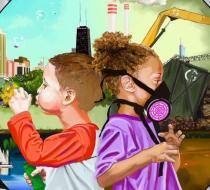Environmental Racism on Display Favorite
Two children stand back-to-back, but they are facing two very different Chicagos. One child blows bubbles in a park under blue skies. The other wears a gas mask against a backdrop of scrap metal and billowing smokestacks.
“The goal was to represent a divide between the community, or between the communities that exist within the upper and lower class,” says artist Sergio Maciel, who grew up in Chicago. “The whole breakdown of the image is to have each child kind of look out into their respective environments and show the differences and the segregation that’s been created within this city.”
Maciel is referring to the structural racism underpinning Chicago and the health inequities and environmental injustices it fuels. It’s the subject of his artwork—on display in two Patagonia storefronts on the city’s North Side—which he hopes will spark dialogue and catalyze action.
The viewing locations for Maciel’s work were chosen very deliberately. One of the Patagonia shops sits across the street from the General Iron metal shredding plant. In May an explosion at the facility sent a plume of smoke over Lincoln Park. Residents of this affluent and largely white community have long complained about pollution from the plant covering their cars and porches with oily film and metallic dust. The explosion didn’t allay those concerns—nor did the explosion five years ago, the plant’s long record of air quality violations, or the fire just last month that sent hazmat crews back to General Iron for the second time this year.
Nobody would want to live near this smelly, noisy, and hazardous place, but General Iron plans to shutter its Lincoln Park facility in 2021 and set up shop on the East Side, a predominantly Latino neighborhood on Chicago’s Southeast Side. The move reeks of environmental racism.
For decades, industries on the Southeast Side have been inflicting their pollution on the area’s communities, which consist mostly of low-income households and people of color, and newcomers like General Iron seem to have no qualms about adding their own messes to the toxic mix. Landfills, coal gasification plants, gigantic piles of petroleum coke, garbage incinerators, buried hazardous waste, PCBs, and manganese dust are just a few of the public health threats that local organizations have been fighting over the years.
Construction began on the new scrapyard in October, and General Iron, which is rebranding itself as “Southside Recycling,” needs just one more permit from Mayor Lori Lightfoot’s administration to begin its operations there in the new year. Meanwhile, prospects for General Iron’s current site on the North Side include high-end commercial development, new residential housing, and riverfront recreational areas—which brings us back to those two children and the divergent environments provided for them.
Along with Patagonia, partners for the art project include NRDC and the Southeast Side Coalition to Ban Petcoke. The coalition was one of three community organizations to jointly file a complaint against the city of Chicago this past summer with the U.S. Department of Housing and Urban Development (HUD) concerning the city’s history of racist land-use decisions. They cited the approval of General Iron’s relocation plans as the main example. HUD responded in October by opening an investigation that could result in huge losses of federal funding for Chicago should it reveal a failure on the city’s part to adhere to the U.S. Fair Housing Act.
“A lot of people aren’t even thinking about what’s happening on the South Side,” says Chicago artist Sam Kirk, the project’s creative director. For both Kirk and Maciel, the artwork is as much about engaging with other communities as it is about shedding light on inequity.
“There’s always going to be differences of opinion, but learning how to communicate with one another … is the strongest aspect,” Maciel says. “The only way to find resolve is to communicate.”
“So much of the fight for us is trying to get other allies,” says Kirk, who cofounded Provoke Culture, an art collective with a mission to celebrate culture and identity. “The overall goal for me is for people to think more unified,” she says, “so that we’re working together to help each other as residents and not against each other.”
Surrounding the children in Maciel’s mural are protesters waving signs. One reads Déjanos respirar, queremos vivir. Let us breathe, we want to live.







